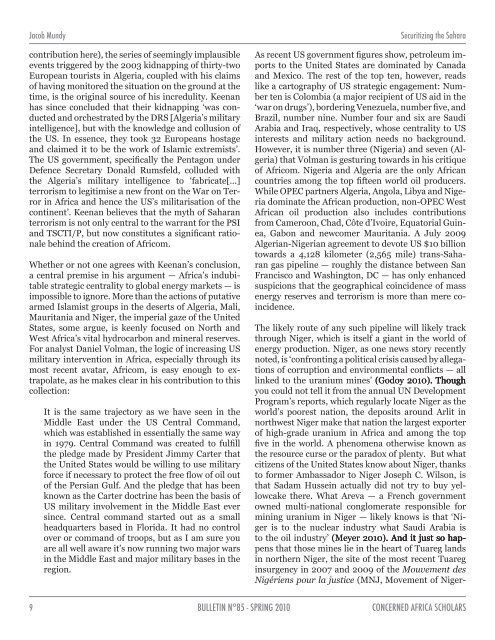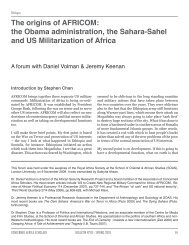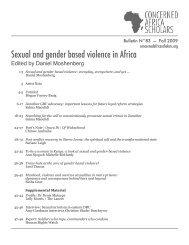Western Sahara and the United States' geographical imaginings
Western Sahara and the United States' geographical imaginings
Western Sahara and the United States' geographical imaginings
Create successful ePaper yourself
Turn your PDF publications into a flip-book with our unique Google optimized e-Paper software.
Jacob Mundy Securitizing <strong>the</strong> <strong>Sahara</strong><br />
contribution here), <strong>the</strong> series of seemingly implausible<br />
events triggered by <strong>the</strong> 2003 kidnapping of thirty-two<br />
European tourists in Algeria, coupled with his claims<br />
of having monitored <strong>the</strong> situation on <strong>the</strong> ground at <strong>the</strong><br />
time, is <strong>the</strong> original source of his incredulity. Keenan<br />
has since concluded that <strong>the</strong>ir kidnapping ‘was conducted<br />
<strong>and</strong> orchestrated by <strong>the</strong> DRS [Algeria’s military<br />
intelligence], but with <strong>the</strong> knowledge <strong>and</strong> collusion of<br />
<strong>the</strong> US. In essence, <strong>the</strong>y took 32 Europeans hostage<br />
<strong>and</strong> claimed it to be <strong>the</strong> work of Islamic extremists’.<br />
The US government, specifically <strong>the</strong> Pentagon under<br />
Defence Secretary Donald Rumsfeld, colluded with<br />
<strong>the</strong> Algeria’s military intelligence to ‘fabricate[...]<br />
terrorism to legitimise a new front on <strong>the</strong> War on Terror<br />
in Africa <strong>and</strong> hence <strong>the</strong> US’s militarisation of <strong>the</strong><br />
continent’. Keenan believes that <strong>the</strong> myth of <strong>Sahara</strong>n<br />
terrorism is not only central to <strong>the</strong> warrant for <strong>the</strong> PSI<br />
<strong>and</strong> TSCTI/P, but now constitutes a significant rationale<br />
behind <strong>the</strong> creation of Africom.<br />
Whe<strong>the</strong>r or not one agrees with Keenan’s conclusion,<br />
a central premise in his argument — Africa’s indubitable<br />
strategic centrality to global energy markets — is<br />
impossible to ignore. More than <strong>the</strong> actions of putative<br />
armed Islamist groups in <strong>the</strong> deserts of Algeria, Mali,<br />
Mauritania <strong>and</strong> Niger, <strong>the</strong> imperial gaze of <strong>the</strong> <strong>United</strong><br />
States, some argue, is keenly focused on North <strong>and</strong><br />
West Africa’s vital hydrocarbon <strong>and</strong> mineral reserves.<br />
For analyst Daniel Volman, <strong>the</strong> logic of increasing US<br />
military intervention in Africa, especially through its<br />
most recent avatar, Africom, is easy enough to extrapolate,<br />
as he makes clear in his contribution to this<br />
collection:<br />
9<br />
It is <strong>the</strong> same trajectory as we have seen in <strong>the</strong><br />
Middle East under <strong>the</strong> US Central Comm<strong>and</strong>,<br />
which was established in essentially <strong>the</strong> same way<br />
in 1979. Central Comm<strong>and</strong> was created to fulfill<br />
<strong>the</strong> pledge made by President Jimmy Carter that<br />
<strong>the</strong> <strong>United</strong> States would be willing to use military<br />
force if necessary to protect <strong>the</strong> free flow of oil out<br />
of <strong>the</strong> Persian Gulf. And <strong>the</strong> pledge that has been<br />
known as <strong>the</strong> Carter doctrine has been <strong>the</strong> basis of<br />
US military involvement in <strong>the</strong> Middle East ever<br />
since. Central comm<strong>and</strong> started out as a small<br />
headquarters based in Florida. It had no control<br />
over or comm<strong>and</strong> of troops, but as I am sure you<br />
are all well aware it’s now running two major wars<br />
in <strong>the</strong> Middle East <strong>and</strong> major military bases in <strong>the</strong><br />
region.<br />
BULLETIN N°85 - SPRING 2010<br />
As recent US government figures show, petroleum imports<br />
to <strong>the</strong> <strong>United</strong> States are dominated by Canada<br />
<strong>and</strong> Mexico. The rest of <strong>the</strong> top ten, however, reads<br />
like a cartography of US strategic engagement: Number<br />
ten is Colombia (a major recipient of US aid in <strong>the</strong><br />
‘war on drugs’), bordering Venezuela, number five, <strong>and</strong><br />
Brazil, number nine. Number four <strong>and</strong> six are Saudi<br />
Arabia <strong>and</strong> Iraq, respectively, whose centrality to US<br />
interests <strong>and</strong> military action needs no background.<br />
However, it is number three (Nigeria) <strong>and</strong> seven (Algeria)<br />
that Volman is gesturing towards in his critique<br />
of Africom. Nigeria <strong>and</strong> Algeria are <strong>the</strong> only African<br />
countries among <strong>the</strong> top fifteen world oil producers.<br />
While OPEC partners Algeria, Angola, Libya <strong>and</strong> Nigeria<br />
dominate <strong>the</strong> African production, non-OPEC West<br />
African oil production also includes contributions<br />
from Cameroon, Chad, Côte d’Ivoire, Equatorial Guinea,<br />
Gabon <strong>and</strong> newcomer Mauritania. A July 2009<br />
Algerian-Nigerian agreement to devote US $10 billion<br />
towards a 4,128 kilometer (2,565 mile) trans-<strong>Sahara</strong>n<br />
gas pipeline — roughly <strong>the</strong> distance between San<br />
Francisco <strong>and</strong> Washington, DC — has only enhanced<br />
suspicions that <strong>the</strong> <strong>geographical</strong> coincidence of mass<br />
energy reserves <strong>and</strong> terrorism is more than mere coincidence.<br />
The likely route of any such pipeline will likely track<br />
through Niger, which is itself a giant in <strong>the</strong> world of<br />
energy production. Niger, as one news story recently<br />
noted, is ‘confronting a political crisis caused by allegations<br />
of corruption <strong>and</strong> environmental conflicts — all<br />
linked to <strong>the</strong> uranium mines’ (Godoy 2010). . Though<br />
Though<br />
you could not tell it from <strong>the</strong> annual UN Development<br />
Program’s reports, which regularly locate Niger as <strong>the</strong><br />
world’s poorest nation, <strong>the</strong> deposits around Arlit in<br />
northwest Niger make that nation <strong>the</strong> largest exporter<br />
of high-grade uranium in Africa <strong>and</strong> among <strong>the</strong> top<br />
five in <strong>the</strong> world. A phenomena o<strong>the</strong>rwise known as<br />
<strong>the</strong> resource curse or <strong>the</strong> paradox of plenty. But what<br />
citizens of <strong>the</strong> <strong>United</strong> States know about Niger, thanks<br />
to former Ambassador to Niger Joseph C. Wilson, is<br />
that Sadam Hussein actually did not try to buy yellowcake<br />
<strong>the</strong>re. What Areva — a French government<br />
owned multi-national conglomerate responsible for<br />
mining uranium in Niger — likely knows is that ‘Niger<br />
is to <strong>the</strong> nuclear industry what Saudi Arabia is<br />
to <strong>the</strong> oil industry’ (Meyer 2010). . And it just so hap- hap-<br />
pens that those mines lie in <strong>the</strong> heart of Tuareg l<strong>and</strong>s<br />
in nor<strong>the</strong>rn Niger, <strong>the</strong> site of <strong>the</strong> most recent Tuareg<br />
insurgency in 2007 <strong>and</strong> 2009 of <strong>the</strong> Mouvement des<br />
Nigériens pour la justice (MNJ, Movement of Niger-<br />
CONCERNED AFRICA SCHOLARS




